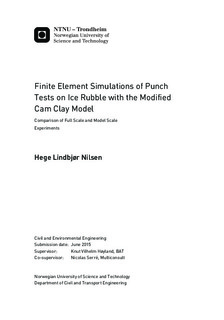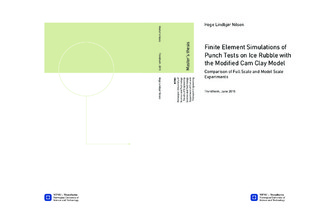| dc.description.abstract | Ice ridges are features created by the relative motion between ice sheets, and
appear as a pile up of broken ice or ice blocks both above (sail) and below
the water surface (keel). First-year ice ridges are important in the design
of offshore and marine structures, but the knowledge about the ice ridge
properties are still limited. Model scale experiments on artificially produced
ice ridges have been developed, leaving the question of how to scale the
properties correctly.
This thesis concerns the scaling of the properties of the unconsolidated layer
of the keel (the ice rubble) from model scale to full scale, as a part of the
determination of ice ridge properties for design. Two types of punch tests
have been simulated numerically in order to study the difference between the
required material parameters:
1. Four full scale punch tests performed in the Gulf of Bothnia in 1999
2. Two model scale punch tests performed at the Hamburg Ship Model
Basin (HSVA) in 2001
The punch tests involve loading the ice ridge with a loading plate while
measuring the resistance from the ridge. The experiments were modelled
in the Finite Element software Abaqus, version 6.12, using explicit analysis.
Both cases were modelled using the Coupled Eulerian-Lagrangian (CEL)
approach, which copes with the challenge of large displacements of the ice
rubble as well as the interface between the puncher and the ridge. The ice
rubble was described using the Modified cam clay material model. This
material model was originally developed for clays and has been used due to
its relatively simple formulation and because it allows for volumetric changes.
The numerical simulations successfully managed to fit the experimental results
until the maximum force was reached. After the peak force, the ice
ridges in the experiments failed in shear. The global failure caused a large
load drop which was not captured in the numerical simulations since the
Modified cam clay model does not include a failure criterion.
The depth measurements of the keel turned out to be vital for the numerical
determination of the keel resistance, underlining the importance of proper
field measurements. The loading of the full scale ice ridges was more complex
than in the model scale tests, and a more advanced numerical model is
probably necessary to properly simulate the entire time history.
The material parameters which influenced the numerical results the most were the stress ratio M and the initial pressure p0. The stress ratio was
about the same for model scale and full scale simulations (1.8-1.85), which
is expected since the parameter is dimensionless and dependent upon the
critical friction angle. The initial pressure was much larger for the full scale
ice ridges, leaving a scale factor of around 20-40. On the contrary,
the length scaling between the two cases were in the order of 10, meaning
that the model scale ice ridges are much weaker than the full scale ridges.
The large initial pressure required in the full scale simulations resulted in
smaller plastic strains than what was the case for model scale. | |

